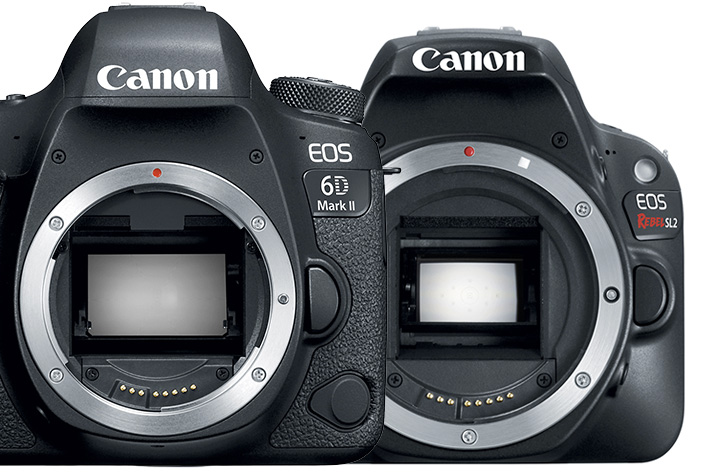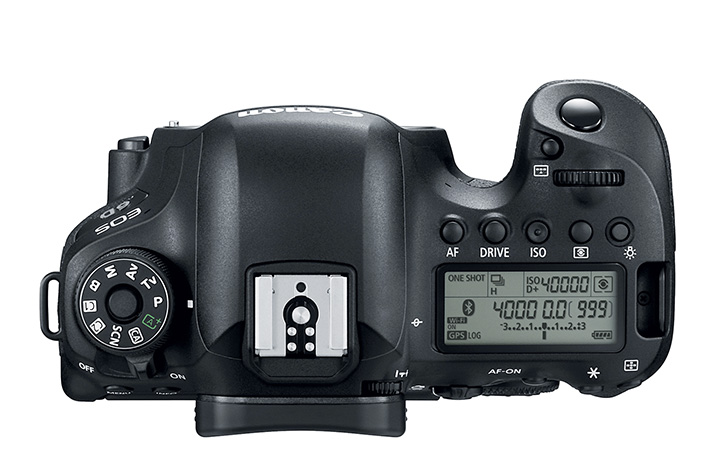
The rumors from recent months get confirmed: Canon has two new DSLR cameras, still without any 4K video in sight, and now with what some consider a bad surprise: the AF array on the EOS 6D Mark II.
Introduced to provide “photographers with improved features over predecessors”, something that should not come as a surprise, although Canon felt the need to mention it, the new EOS 6D Mark II and EOS Rebel SL2 DSLR cameras are designed for advanced-amateur and entry-level photographers, respectively.
The EOS 6D Mark II camera, and let’s follow Canon on this, “is ideal for budding photographers looking to take their creative DSLR photography skills to the next level by shooting with a Full-frame CMOS sensor DSLR camera to capture beautiful high-quality portraits and striking landscapes, even in low-light situations. The EOS Rebel SL2 is a small, light, and compact camera with high-performance capability that allows users to get creative when capturing their special family moments or travel experiences.”
“It seems fitting that today, a day set aside to commemorate the invention of a tool that forever changed how we view the world, we introduce two new DSLR cameras to the Canon family,” said Yuichi Ishizuka, president and COO, Canon U.S.A. “In an industry where choices are abundant, providing consumers with the photographic tools that match their developing skill levels as they continue to embrace their passion for photography is a long-standing goal of Canon and stands at the core of our research and development. The new EOS 6D Mark II and EOS Rebel SL2 DSLR cameras are the result of Canon’s dedication to providing a wide range of camera choices for photographers of all skill levels, whether it’s someone taking their first picture or video with a DSLR camera or those looking to make the jump to a Full-Frame sensor camera.”

The information provided by Canon in its press-release is scarce, in technical terms, as if the company did not feel the need to say more about a camera that, in fact, is the substitute for the initial EOS 6D. It’s another entry-level full-frame camera. As Canon puts it, “Designed with enthusiast photographers in mind, Canon’s popular and versatile EOS 6D DLSR camera historically served as the gateway for enthusiasts to step-up to Full-Frame DSLR cameras.” So, now that we’ve had that much of information, let’s look at the specs of the EOS 6D Mark II, as presented by Canon:
- 26.2 Megapixel Full-frame CMOS Sensor
- Optical Viewfinder with a 45-point All Cross-type AF System
- Dual Pixel CMOS AF with Phase-detection & Full HD 60p
- DIGIC 7 Image Processor, ISO 100-40000
- Vari-angle Touch Screen, 3.0-inch LCD
- Built-in Wi-Fi, NFC, Bluetooth and GPS technology
- High-speed Continuous Shooting at up to 6.5 fps
- Dust- & Water-resistant
For a moment you might think you’re looking at the specs of an EOS 80D, bar things like the sensor, which is 26.2 against 24.2. In fact, the EOS 6D Mark II uses a lot of the technology from the EOS 80D, including the same 45-point All Cross-type AF System, which works fine but, apparently, was transplanted here “as is”. Meaning Canon did not bother to change the position of the AF points. While the system works well on the APS-C sensor of the EOS 80D, it looks ridiculous on the EOS6D Mark II, as the AF points are so close together that it makes almost no sense to select one over the other.
I went back to look at some of my cameras, and even the EOS 10D offers a better coverage of the whole sensor area than the EOS 6D Mark II. The same for the EOS 20D, the EOS 50D… They are all APS-C models, though. But the sensor array for a full frame should mimic the same coverage, I believe. This said, one has to remember that when using Live View and the touch screen on the back, the AF coverage will be wider, covering 80% of the frame, just like the EOS 80D.
Maybe Canon has a point, after all. From my own experience, although I select different AF points for many situations, I also tend to use the central AF point or group and reframe the image, something inherited from a time when the central AF point was the REAL only AF point that worked well. Although things have changed, old habits never die. Maybe Canon has discovered that many users do not rely on lateral AF coverage, and decided altogether that the sensor array from the EOS 80D was good enough for an entry-level camera.
Armed with a touch screen and Dual Pixel AF CMOS, the technology that now no one seems to want to live without, the EOS 6D Mark II may seem to be the entry-level for video in the full-frame class, but make no mistake, this is less of a video camera than the EOS 80D, as it lacks things as headphone socket. And, for those who love to see it mentioned again, yes, it’s only Full HD 60p. Everybody says it would be great to have a 4K camera with DPAF… well, there is one, the EOS C200. Only the price is slightly different, as the EOS 6D Mark II DSLR, which is scheduled to be available in late July 2017, will cost $1,999.00, body only.
The second DSLR introduced by Canon is the EOS Rebel SL2, presented as the camera for those wanting to step up “from a smartphone or point-and-shoot camera” but intimidated by so many knobs and menus. The small and lightweight DSLR is Canon solution to alleviate some of those concerns for first-time DSLR users.
When designing the new EOS Rebel SL2 camera, Canon took into consideration feedback from entry-level photographers who expressed interest in learning how to go beyond a camera’s program mode. The result was the creation, says Canon, “of a convenient new user interface called Feature Assistant. With the EOS Rebel SL2 camera, users will be able to see on the camera’s Vari-angle Touch Screen how switching modes on the mode dial or tweaking camera settings like aperture and exposure compensation can alter the image they are about to capture, thus guiding photographers on their way to capturing more compelling images, such as ones with a shallow depth-of-field or being able to give moving subjects a frozen or flowing look.”
The EOS Rebel SL2 DSLR camera features several other enhancements over its predecessor model, the EOS Rebel SL1, including:
- 24.2 Megapixel CMOS (APS-C) Sensor
- Dual Pixel CMOS AF
- 3.0-inch Vari-Angle LCD Touch-Screen,
- Built-in Wi-Fi, NFC and Bluetooth Technology
- Full HD 60p & External Microphone Input
- DIGIC 7 Image Processor, ISO 100-25600
- Optical Viewfinder with a 9-point AF System
- Feature Assistant
- Small and Lightweight Body
Again, the EOS 80D seems to be the base for this stripped down version. It’s interesting to see Canon expand the use of its Dual Pixel CMOS AF even to entry level models, aware of its role as an asset for the brand and something that consumers will appreciate. The original EOS Rebel SL1 used Hybrid CMOS AF II, which was less performing than this method.
The EOS Rebel SL2 is scheduled to be available in late July 2017 for a retail price of $549.99 for body only and $699.99 with the Canon EF-S 18-55m f/4-5.6 IS STM lens, which is a good kit lens waiting to be discovered by users. Much better than anything a smartphone can offer you.


